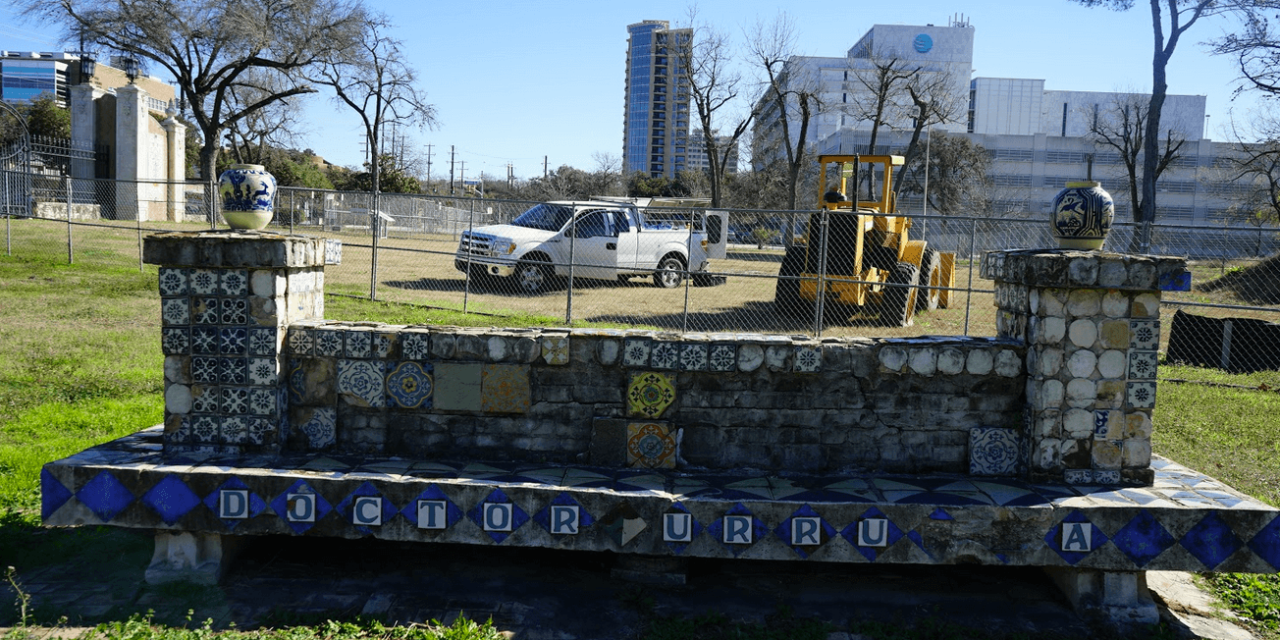The heavy rainfall over the fall months of 2018 delayed conservation work on Miraflores, one of San Antonio’s most fabled gardens. The rain showers flooded the water table under the garden’s grounds and as a consequence water overflows and fills the low spots of the garden. There are no easy answers for keeping water from coming up through the grounds which currently is creating a multitude of shallow ponds.
Miraflores was the brainchild of Dr. Aureliano Urrutia, the former Minister of the Interior under the presidency of Victoriano Huerta. President Huerta ruled Mexico from 1912-1914. Dr Urrutia had been the personal physician of the previous two Mexican presidents but in 1914 he fell out of favor with Huerta.
Urrutia fled Mexico in 1914 at about the same time that United States Army Major General Funston arrived in Mexico with orders to block the port of Veracruz. The United States had refused to recognize Huerta’s government, and with rebel forces led by Francisco Villa and Emiliano Zapata closing in on Mexico City, Huerta fled to Spain. Urrutia, sensing great danger for all of Huerta’s appointees, booked passage to Galveston, Texas and then traveled to San Antonio where he practiced medicine.
Dr. Urrutia bought the 15 acre garden adjacent to the San Antonio River in 1921 and over the next forty years he entertained guests at Miraflores, including the famous Mexican movie star Dolores Del Rio. The beautiful outdoor benches, tables and tile arches were the work of Dionicio Rodriguez, famous for his cement faux bois (imitation wood).
In its prime, during the years 1921-1960, Miraflores was one of the most beautiful gardens of the city. Elise Urrutia, the granddaughter of Dr. Urrutia, wrote that “Urrutia used Miraflores as his outlet for creative expression, and between 1921 and 1930 he fashioned the property into a fantastic garden of statuary, fountains, pools, and meandering waterways.”
In 1960 Dr. Urrutia sold his residence on Broadway to a car dealership and moved for a time to his Quinta Maria cottage in Miraflores. Shortly afterwards, he sold his Miraflores property to USAA and moved to Monte Vista. He died in San Antonio in 1975 at the age of 103.
The work of the Brackenridge Conservancy is to effectively preserve the artifacts, trees and plants of Miraflores. The Conservancy also faces the challenge of restoring Quinta Maria, the summer home of Dr. A. Urrutia.
Elise Urrutia, who is writing a book on the life of her great grandfather, commented recently that “Unfortunately, Miraflores has suffered remarkable decay under ownership by various corporations” which took over the gardens following the sale of the property in 1960 when Urrutia retired. The garden, she observed, is currently “flattened, defoliated, and in a struggling state of advanced disrepair.”
Of the original 15 acres of Miraflores gardens only four and a half acres of the original land remain. The garden’s location next to the San Antonio River and adjacent to Brackenridge Park makes it prime parkland for city residents. Across the street on the campus of Incarnate Word University are the headwaters of the San Antonio River.
With the blessing of the Brackenridge Conservancy led by the very able director, Lynn Bobbitt, I toured the grounds recently with Tim Palomera, a former City of San Antonio Architect. We were not there to solve any environmental issues, just to contribute to documenting the architecture and other historical artifacts on the property. The main arch of the garden has been moved to the San Antonio Museum of Art. However, there are still many treasures to enjoy in Miraflores.
Writing for Texas Architecture in 2007, Walt Lockley commented that Miraflores “looks like a neglected, overgrown private cemetery, except instead of headstones, it’s a collection of statues and architectural fragments. Mysterious. And off-limits to the public.”
Miraflores is too marvelous a treasure of nature and art to neglect. Elise Urrutia reflected on her grandfather’s homestead and noted that “The garden was, because of his particular outlook, a detailed lesson in the uniqueness of Hispanic culture–a lesson that, if we can recover it, could be a beautiful gift to our citizens and visitors to our city.” She is certainly right, and all San Antonians should hope that one day Miraflores will be restored to its old glory.










